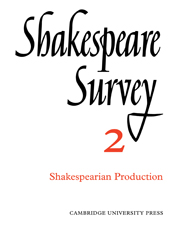Book contents
- Frontmatter
- Fifty Years of Shakespearian Production: 1898–1948
- An Original Drawing of the Globe Theatre
- The Projected Amphitheatre
- Ben Jonson and Julius Caesar
- The Booke of Sir Thomas More and its Problems
- The ‘Shakespearian’ Additions in The Booke of Sir Thomas More
- The Renaissance Background of Measure for Measure
- The Individualization of Shakespeare’s Characters through Imagery
- Trend of Shakespeare Scholarship
- Shakespeare in France: 1900–1948
- International News
- Shakespeare in New York: 1947–1948
- The Year's Contributions to Shakespearian Study 1 Critical Studies
- 2 Shakespeare’s Life and Times
- 3 Textual Studies
- Books Received
- Index
- Plate section
Fifty Years of Shakespearian Production: 1898–1948
Published online by Cambridge University Press: 28 March 2007
- Frontmatter
- Fifty Years of Shakespearian Production: 1898–1948
- An Original Drawing of the Globe Theatre
- The Projected Amphitheatre
- Ben Jonson and Julius Caesar
- The Booke of Sir Thomas More and its Problems
- The ‘Shakespearian’ Additions in The Booke of Sir Thomas More
- The Renaissance Background of Measure for Measure
- The Individualization of Shakespeare’s Characters through Imagery
- Trend of Shakespeare Scholarship
- Shakespeare in France: 1900–1948
- International News
- Shakespeare in New York: 1947–1948
- The Year's Contributions to Shakespearian Study 1 Critical Studies
- 2 Shakespeare’s Life and Times
- 3 Textual Studies
- Books Received
- Index
- Plate section
Summary
To attempt an interim report upon Shakespearian production during the last fifty years is not quite so presumptuous an undertaking as the title might seem to imply. Is is a good moment for taking stock of the situation, because we have now reached a position which can be apprehended and defined and can see how and why we have arrived there. Development goes on, but in the main we are working with assurance in an accepted mode. Practical experiment in the theatre, inventiveness and ingenuity have for the time being made their important and sufficient contribution, and are incorporate now in a new and vigorous tradition. It is, in fact, one of those propitious moments when mastery of technique and of material means is so assured that it should enable the fullest concentration of energy to be focused on essentials—in this case, upon the fundamental brain-work applied to the author’s text to discover meaning and dramatic structure and purpose.
The Scenic Heritage: Charles Kean and Henry Irving
To understand the methods and achievements of Shakespearian production in the first half of this century we must turn to the last fifty years of the nineteenth. The work of Beerbohm Tree at His Majesty's represents the culminating point in the history of spectacular Shakespearian presentation, which goes back by way of Irving and the Lyceum in the eighties and the nineties to Charles Kean and the Princess's in the fifties. Granville-Barker's Savoy productions and the first fifteen years of the Old Vic take us back to William Poel and the early work of F. R. Benson, and so back to Samuel Phelps and Sadler's Wells. No one is likely to ignore or undervalue the influence of European ideas in general in the English theatre since 1900, more especially the influence of Germany and Reinhardt in Shakespearian production; but our roots to-day are still, as they always have been, deep in our own past.
- Type
- Chapter
- Information
- Shakespeare Survey , pp. 1 - 20Publisher: Cambridge University PressPrint publication year: 1949
- 1
- Cited by



